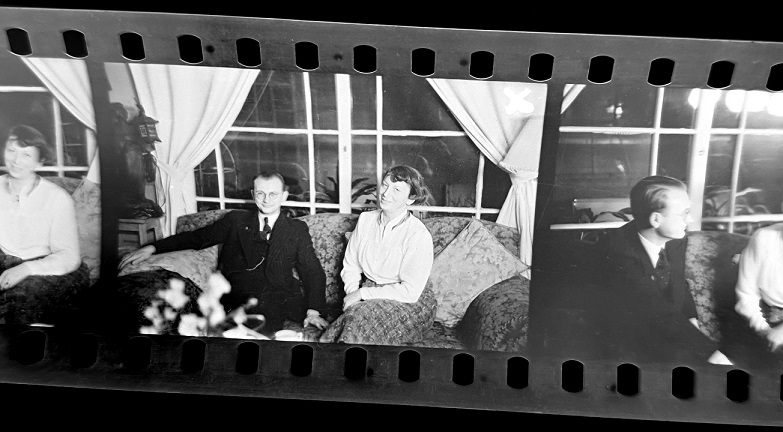
The mystery of found negatives
By Andrew Warland (Melbourne, Australia), with Shinya Ota (Yokohama, Japan)
My father, Ian Warland, enlisted for WW2 in early November 1944 and joined the Royal Australian Navy. He trained at the Flinders Naval Depot (FND) until the end of September 1945, and then joined the HMAS Hobart in Sydney in early October 1945. The Hobart had just returned from Japan where it was present at the surrender ceremony in August 1945. The Hobart headed back to Japan in early November 1945.
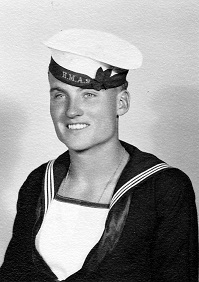
Ian Warland in 1945
The Hobart arrived in Yokohama on 17 November 1945. Two days later, my father went ashore to look around. He wrote to his girlfriend Pam Robertson (who would later be my mother):
We (made) our way to Yokohama, about a mile away. A few Japs were hanging around, and kids asked us for gum. After walking a couple of hundred yards we hailed a Yank truck full of Jap kids, and rode the rest of the way. Canals are full of sunk barges. Soon we saw bomb damage. Piles of smashed cards, and flattened buildings. There are acres of flattened and bar spaces, and the Japs have built shanties on them, where they sell their silks and other curios. ... Very little food is sold on the streets. There are no shops, all having been smashed up and flattened.
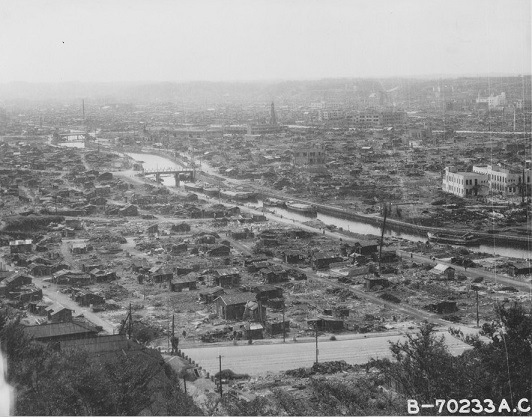
A photo showing the destruction of Yokohama in November 1945. (Source: World War II Database)
Dad was assigned to guard the British consulate (see photo below) from Monday 3 December 1945 and went ashore on the Sunday to draw gear and prepare. The consulate itself may have been unoccupied. During the period January 1942 to June 1946 nobody was posted to Japan because of hostilities during the Second World War. He said in one letter that the (presumably living) quarters or mess were 'a bit buggy' (meaning dirty), '... but we got the Nip boys on it and scrubbed it out'. He also mentioned the 'wardroom' being where senior, probably British officers, were working in the building. In one letter dated 12/13 December 1945, dad said he was asked by some nurses who passed by what the place was; he replied 'Nothing much', indicating it was not in much use.
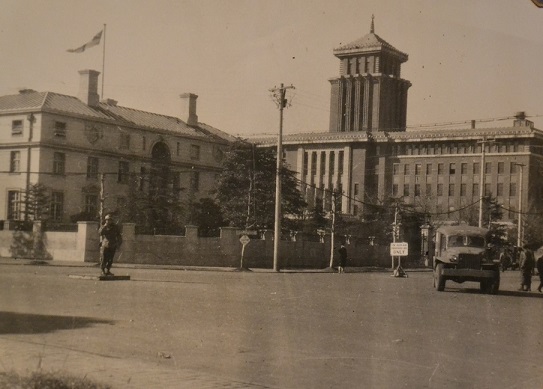
A photo of the British consulate in 1945/1946
In his own personal story that he wrote after he retired, dad wrote:
One day I was poking into some desk drawers at the Consulate and I found some films that had obviously belonged to the staff. They were photos of the family of the Consulate staff, and some of the Japanese domestic staff. I took the films into my possession and when I occasionally take them out of their case, I wonder what happened to the Consul and his family.
Dad never really mentioned these films and I had forgotten about this paragraph. We probably assumed it was a reference to the photos in the album he put together on this return. He didn't have his own camera, though. In one of several references to a camera, dad wrote on 19 December 1945, 'I wish I had the camera here. I have had plenty of chances to take photos'.
Dad re-joined the Hobart on 29 December 1945 for a cruise to Kure and Shimizu. During this time he also visited Hiroshima. In a letter dated 23 February 1946, he wrote 'I bought some good photos of Kure and Hiroshima yesterday. A P.O. Signals takes them and sells them on board. They are pretty good, and of course good as souvenirs.'
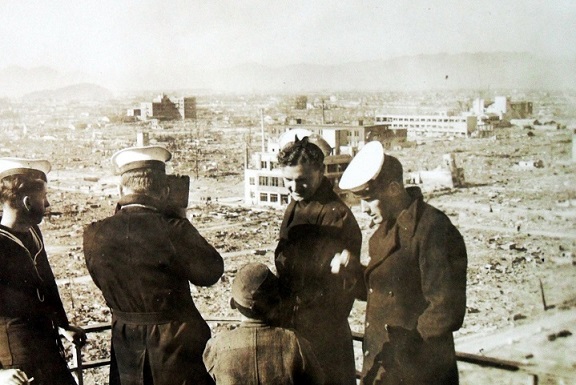
One of many photos taken in Japan, and bought by my father (he may be the man second from right talking to the young boy)
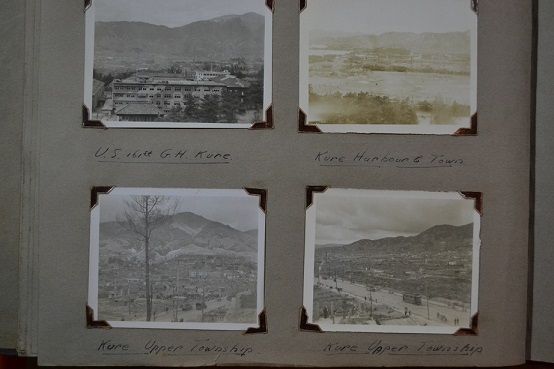
A page from my father's Japan album, showing photos from Kure.
My father died in April 2012, nine months after my mother. After his death, my sisters and I began the job of cleaning out their house. As the family historian, I took the old photograph albums (including the Japan album), letters, and other family memorabilia back to Sydney for safekeeping.
The Yokohama photos
In mid 2013 I was looking through the (large) box of family history material and noticed three old aluminium film canisters.
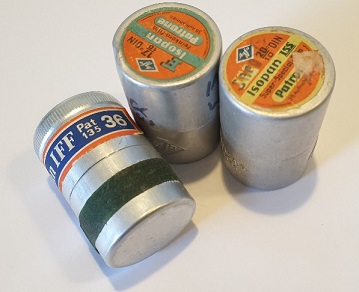
The three original film canisters
One of these canisters contained the black and white negatives taken at my parent's wedding in 1951. A second contained black and white photographs of my two older sisters and myself from the early 1960s.

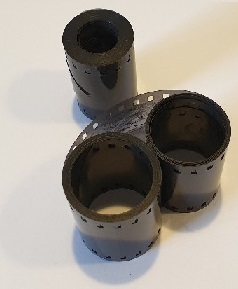
The two rolls inside one of the canisers
The third canister contained two tightly rolled rolls of black and white negatives that appeared to be of a parade in Japan on one, and a family on the other.

An unknown couple
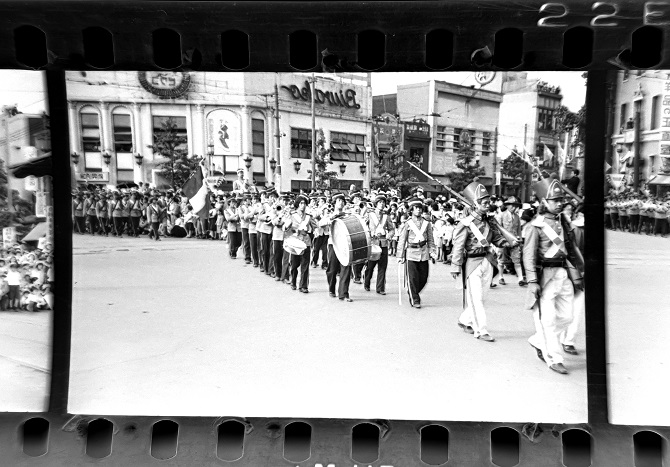
A photo from the parade
It was an obvious conclusion to draw that these photos were probabaly taken by my father when he was in Yokohama. An American historian based in Japan who I had been in contact with about another matter confirmed that the parade photos were almost certainly taken in Yokohama as one of the banners in the procession had the Japanese characters for 'Yokohama'. Again, I assumed that my dad had taken (or perhaps bought) the photos - but hadn't printed them, for some reason. It was not clear who the family was in the second roll, but I assumed they were people he had met while he was there, perhaps even the British consul and his family.
I had forgotten to check my dad's personal story, but in any case, the mystery of who took the photos, when, and who the people were in the photos remained.
Never assume anything
In an attempt to find more details about these photographs I searched the internet, looking at Google street view to try to find where the photos had been taken. I found a blog post - Weekend Walks in Yokohama - by Shinya Ota.
Shinya clearly knew Yokohama very well and so I emailed him to see if might be able to help me understand where my father had (apparently) taken these photos. His initial reply was 'If I remember correctly, the port opening parades were resumed around '50s after the war. But I heard from my parents the US army stationed here had held parades a few years since they occupied the town. That may be the one your dad took in pictures.'
In his next email, Shinya was able to identify details and pinpoint the likely place where the photos were taken - at the crossing of Bashamichi and Onoe cho. He again noted that the parades re-started in 1953. Shinya then very kindly tried to help with identifying the potential location of the house in the family group. Since my father had been a guard at the British Consulate, the assumption was that the family might have been the British Consul, at home, in the British consulate's home in Yamate. Shinya visited that location (now open to the public) and found that the windows did not match. So, it was probably not the consul or his home.
Doubts emerge
By early June 2021, both myself and Shinya started to have some doubts about the presumed dates, people and locations in the photos. There was one major problem with my father's photographs - the buildings were mostly intact and the city looked more or less normal. This conflicted with my father's description of the city and the few photographs that existed.
As I had my father's almost daily letters back home to his mother and Pam Robertson, I decided to transcribe them, which took about a week to complete. While I was doing this, Shinya sent me an email with the photograph below.
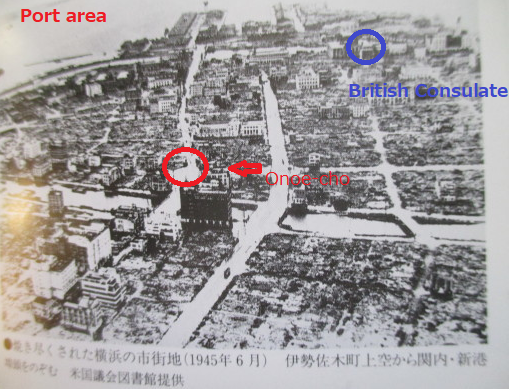
A photo from Yokohama in 1945 showing the destruction and where the parade would have taken place
In his email, Shinya said:
I know the US military targeted mostly both industrial areas and residential areas of the town excluding Yamate hill area and Port area during the air raids. The Onoe-Cho street with the Matsuya building in the picture looks relatively clean. People are wearing clean clothes. Soon after the war, people were struggling to survive: women wearing a sweatsuit-like Kimono called 'Monpe', men with a suit like a military uniform. So, there is a possibility the pictures may have been taken later. People are wearing early summer clothes in the pictures.
The photo above shows the area in the parade, but there was massive descruction the end of 1945 AND my father was there in the middle of a cold winter. There was something wrong with the timeline - the photos could not have been taken while my father was working in the consulate in Yokohama and his personal story seemed to suggest that they were taken by the Consul. So, when were they taken?
Shinya continued to look for more information and visited the Archives of Yokohama History where he showed the photos of the parade to a researcher. According to Shinya, '... He was very surprised to see such a lot of pictures of the parade. He examined them and agreed this is around Onoe-cho, Bashamichi street but was not able to determine when they may have been taken. He mentioned we had some parades to cerebrate something occasionally before they resumed the port opening costume parade in 1953'.
In late June 2021, Shinya looked into various photos and other literature at the Yokohama Archives and the city library and advised that he thought the parade's pictures and summer festivals might be from before the war. He added that 'the area the pictures of the parade show were turned into rubble by the air-raid.' This was exactly what my father had said in his letters.
Shinya was able to identify very specific clues that helped to date the photographs. For example, in the photograph below, the advertisement for 'Kinema Soup' was placed in that location around 1935. The arch 'Isezaki Cho' in that design at the entrance of Isezaki. Neither of of them appear in pictures during the occupation period after 1945.
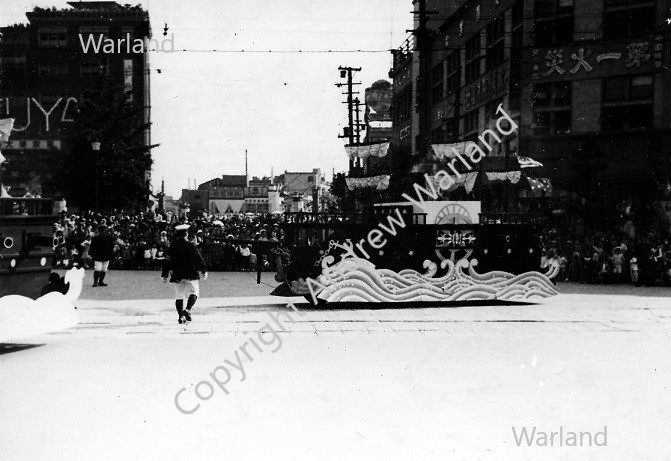
In another image (below), Shinya identified that the police officers were wearing a uniform with stand-up collar, which was only worn before the occupation.

In a third photo (below), the Japanese Imperial 'Rising Sun' flag that was not allowed after 1945 in public can be seen in the background.
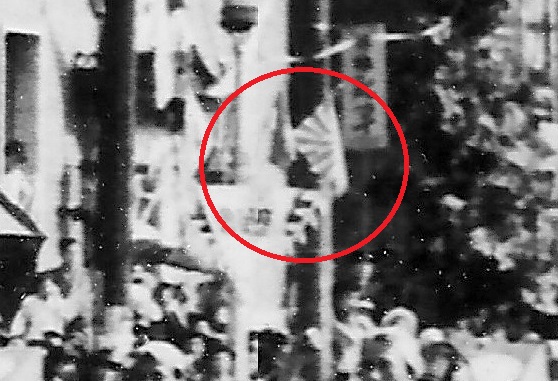
It was now fairly clear that the photos were taken before the war. It might make sense that the Consul (or someone else) simply left the negatives in the consulate when it was closed at the beginning of the war.
The negatives reveal further clues
I decided to look more closely at the negatives from Japan. Both had the words 'Eastman', 'Kodak', 'Nitrate Film' and 'Panchromatic' along with some kind of code next to the word 'Kodak'. According to the website Preservation and Treatment: 'The use of nitrate base in 35 mm still camera film ended in 1938. Eastman ended the use of nitrate base in commercial and professional sheet film in 1939.' Kodak phased out all nitrate base film by 1951. So it seemed likely that the negatives were dated from before 1939.
The special codes next the word 'Kodak' provided even more specific clues. The chart below shows when the films were made, based on the code. All the films listed in the left hand column were made in Rochester, USA.
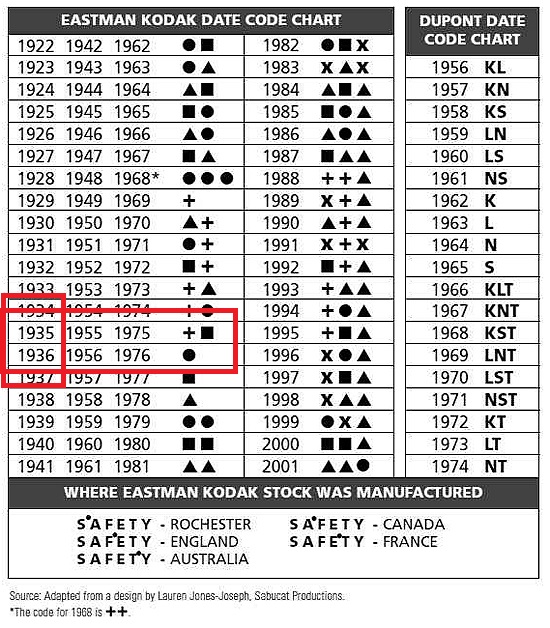
Based on this embedded metadata, I could see that the roll that showed that photographs of the family (below), with the code + and a square, was made in 1935.
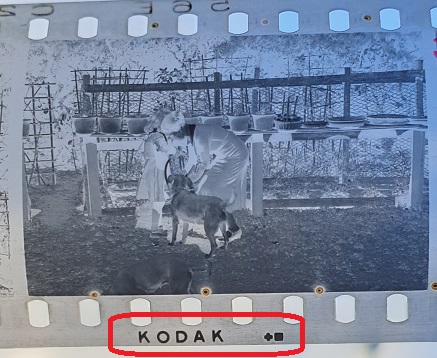
The second roll of the parade has the circle code indicating it was made in 1936.
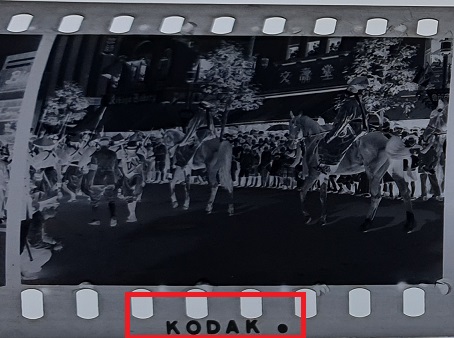
We now had very specific dates for both the family photos and the parade, confirmed by Shinya's research. But we were still left with the problems of knowing who the family group was. If there was no Consul when my father was there, but the photos were taken in 1935 or 1936, who was it?
The British Consul-General's residence (1920 - 1939)
According to the Room for Diplomacy website, the property at Yamate cho 18 (18 The Bluff, in the Yamate foreign settlement), now 16 Yamatecho, Naka Ward, Yokohama) was exchanged in 1920 for lot 155 of Yamashita Cho, and became the consul-general's residence from 1920. The image below (from the Room for Diplomacy site) shows the layout of the property at Yamate cho 18.
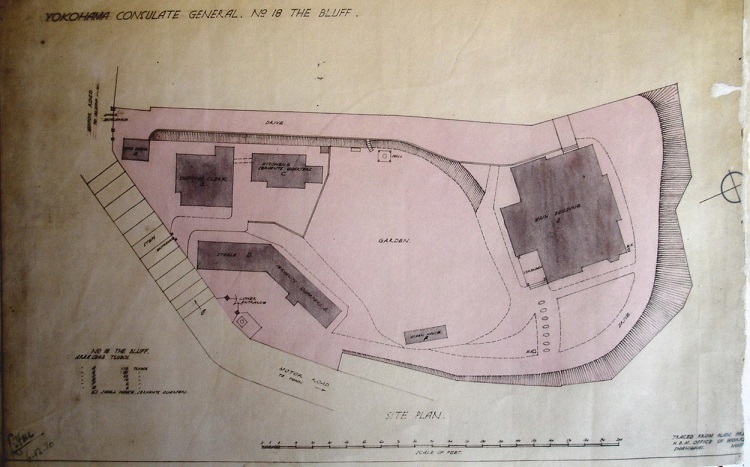
The original British Consulate (with living quarters on the top floor) at Lots 172-3 Yamashita-cho, built 1870, shown in the photograph below, along with most of the other residential buildings, were destroyed in the 1923 earthquake that destroyed much of Yokohama. It is not known if the original property at 18 The Bluff was destroyed or not but either way, the British Consul-General appears to have continued to live at that address.
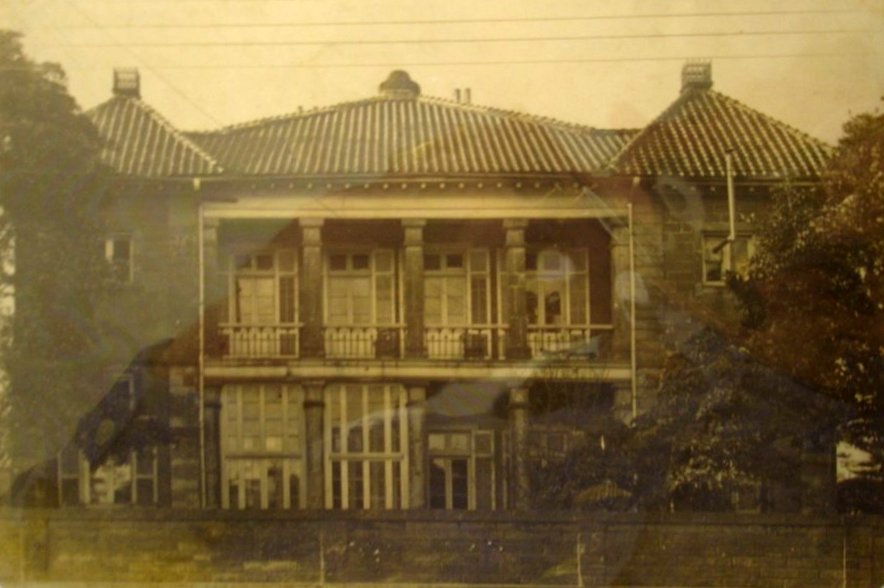
Unfortunately, the rest of the consulate staff were less lucky in terms of finding a place to live after the earthquake. The Room for Diplomacy website states that, after the earthquake in 1923, 'The consulate rented accommodation for one month aboard a steamer in the harbour while a flimsy single-storey hut, with thin timber boarding externally and tarred paper internally and a corrugated iron roof, was erected for the offices on the devastated site. This building, although it was propped up and tied down in 1926, had to suffice until 1930. The staff moved into whatever rentable residential premises they could find, including on board ships chartered to lie at Yokohama, and remained peripatetic for the next fifteen years.'
Whether or not the residential buildings at 18 The Bluff were destroyed, the Consul-General appears to have continued to live at that property after the earthquake and until the new residence was completed in 1939.
Parts of the current building and layout of the property at Yamate cho 18 bear a strong resemblance to the building and grounds that can be seen in the photographs taken in 1935 or 1936. For example, the windows in the background of the photographs are the same style and appear to match windows in the current upstairs area (see photo below of the current building). Similarly, the open yard and garden area in front of the house looks similar to the more recent view.
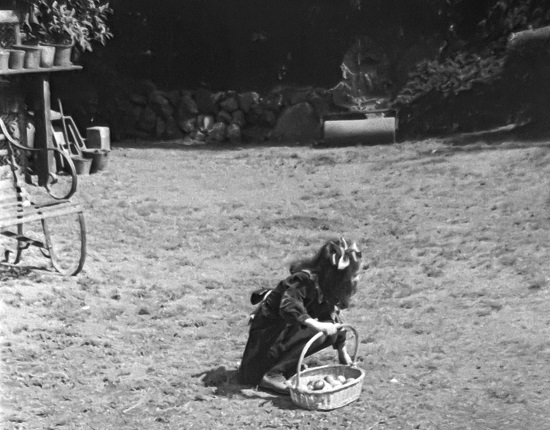
Front garden of British House in 1936 showing some form of retaining wall in the background.
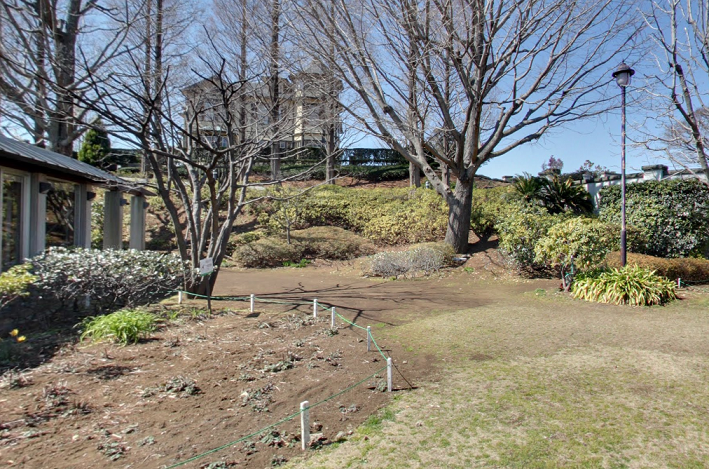
The yard and garden area in 2021 from the same aspect. The retaining wall has been replaced with a sloping garden.
In the earlier photos, the garden has raised platforms with pots, the edge of one of which platforms can be seen in the first photo above. Behind these platforms appears to be a vegetable garden. There is now an annex over that area, suggesting (perhaps) that previous owners had erected a glasshouse where the raised platform and garden beds were. In the earlier photos, two metal park benches can be seen; almost coincidentally perhaps, there are two wooden park benches in the current garden. This suggests that the area was a pleasant place to sit.
Lastly, one of the photographs shows what appears to be a rear or side door with wooden walls. This may be the original side entrance with a wooden portico, that has since been replaced and extended.
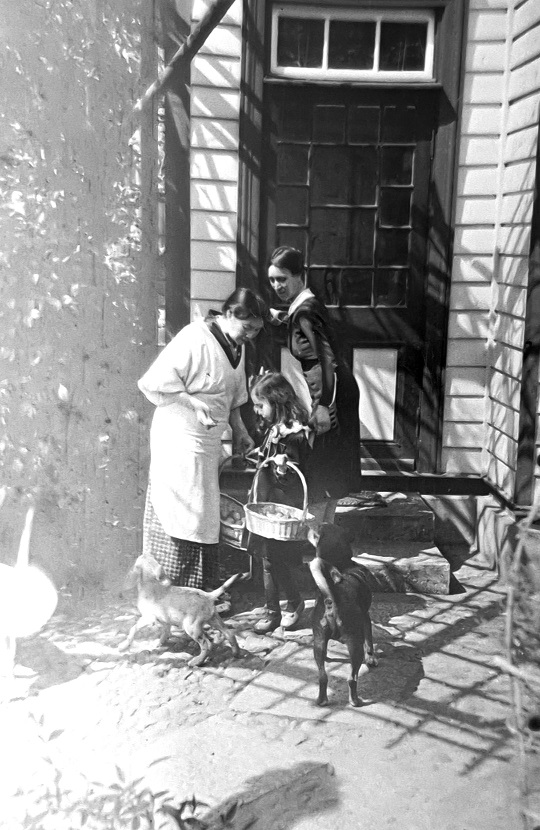
The original side door.
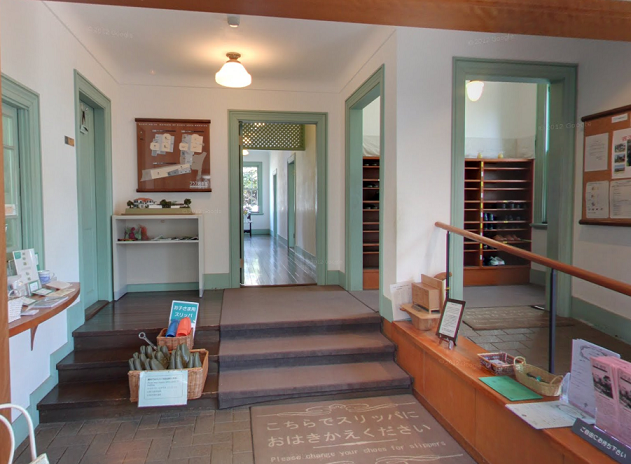
The current side entrance, which leads to the annex where the garden beds used to be located
One of the primary differences between the earlier photos and the current building is that the original photos appear to show that there was wood panelling along the lower third of the walls, whereas this does not exist in the current building - potentially because it was removed.
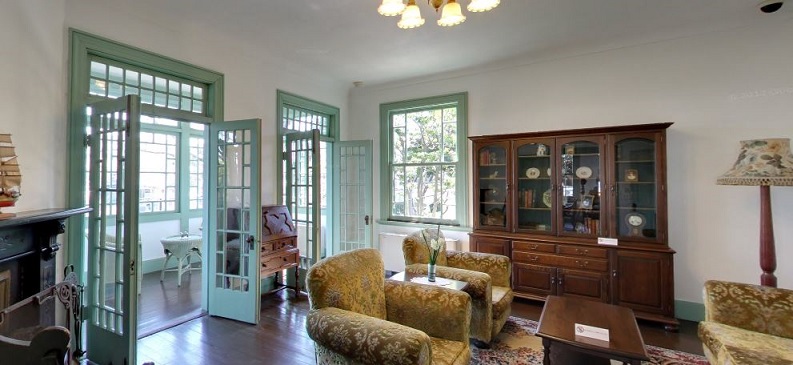
The British Consul-General's residence from 1939
The current building, which was vacated by the British Consul when the new residence was completed in 1937, became residence for the Catholic priests in 45 Yamate Cho until 1991.' The British Consulate was closed in 1958.
The photograph below is of 'British House', the official residence of the British Consul in 1939. See the Room for Diplomacy website for more details including the plan and original photo from 1939.

The above discussion would appear to confirm that the photographs were taken around 1937 in the old residence. The question now is, who are the people in the photos?
Who are the people in the photos?
Ernest Hamilton Holmes
Until mid-September 2021 it was believed that the photos might be of Ernest Hamilton Holmes, CMG (The Order of St Michael and George) his second wife Florence (his first wife Jamesina died in 1936) and possibly two of his children. Holmes was Consul-General from 1921 until 1936. Members of the Holmes family have advised that these photos are probably not of EH Holmes or any members of his family.
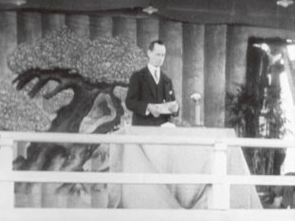
A photograph of E Hamilton Holmes in 1929 in a Japanese language newspaper). He looks very similar to a photo taken in the 1940s in England, and unlike the man on the sofa in the photos above.
Reginald McPherson Austin
Reginald McPherson Austin (1887, Bromley, Kent - 2 July 1950 Englefield Green, Surrey, England). Austin was Consul-General from late 1936 to late 1941 (or early 1942). It is not yet known exactly when Austin arrived in Japan but he married Aileen Tierney Graves Hansell (born in Kobe, 1893) in Kobe, Japan, on 10 October 1917. They did not have any children.
As at the end of September 2021, and although the negatives have date stamps of 1935 (family) and 1936 (parade), it is believed that the man and woman sitting on the sofa are most likely Reginald McPherson Austin and his wife Aileen (nee Hansell), photographed in April 1937 (or possibly 1938) based on the following:
- The man on the sofa does not resemble EH Holmes (based on photos and family advice) and is definitely not the Vice-Consul Wilfrid Woltars McVittie (also based on multiple photos) although there is a possible link with Smyrna - see below.
- The negatives were found in the office of the Consul-General's office in the British Consulate in Yokohama in December 1945. This would seem to indicate they were of some value to the Consul-General, but it is not clear why they were left for so long after they were taken. Perhaps these negatives were the only ones considered to be of no value.
- Austin was the last Consul-General, leaving in late 1941 or early 1942 (possibly without much opportunity to pack up his office).
Despite the above, it is also possible that the couple, young woman or child in the photos are visitors (friends or relatives), whose identity will remain unknown.
The Smyrna connection
There are several connections with Smyrna (then Greece), now Izmir (Turkey) with the people in the British Consulate from 1937.
Enoch Joyce Smithers - US Consul in Smyrna
Enoch Joyce Smithers (born in Delaware in about 1811), was a US Civil War veteran and later a US State Department employee. In 1861, after spending time in the Civil War with the First Regiment of Delaware Volunteers, he was appointed (by President Lincoln, no less!) to be the US Consul at the newly created legation on Chios, then a Turkish-occuped island. He was then posted to the 'Turkish Dominions' from 1865 and was the US Consul in Smyrna from 1880 (or earlier?) until around 1883. This puts him in Smyrna at the same time as the McVitties and others who appear below. In 1883, he was posted to Chin Kiang, China. Then, at the age of 80, in 1891, he posted to Osaka and Hiogo where he met the younger Englishman Alexander Nelson Hansell who had been in Kobe (near Osaka) since 1888.
EJ Smithers and his wife Charlotte (also Smithers) had five children, several of whom were born in Smyrna. This puts them in the same timeframe as some of the McVittie relatives noted below.
- Amelia Joyce Smithers (1865 - ). Married the German national Alfred Carl Marx Hermann Buschel (1867 - 1916) in Kobe in 1898. They had two children, Eric Victor Buschel (1899, Kobe - ) and Margeurite Buschell (1901, Kobe - ?), about whom nothing more is known, except they were German citizens and lived in Germany. It is not impossible that one of them visited their cousin in Yokohama in the 1930s.
- Mary Elizabeth Smithers (1868, Smyrna - USA?).
- George Fisher Smithers (1870, Smyrna - 1945, Washington?). Never married.
- Harry Baker Smithers (1873, Smyrna - 1950, Virginia, USA). Never married.
- Elsie Skinner Smithers (1875 - ). Married Alexander William Crombie (1873 - 1915, Kobe, Japan)) in Kobe on 13 September 1899). They had one child, Bessie (Christina) Crombie (24 June 1907 - 1991, Newcastle upon Tyne). Bessie married Walter L J Stevens in April 1936 in Surrey, it is not known if they had children.
Alexander Nelson Hansell - Marries the daughter of EJ Smithers
Alexander Hansell (born around 1857) was an Englishman who moved to Japan in 1888 first teaching and then becoming an architect in the Kobe/Osaka area. One of his works, 'Guggenheim House' in Kobe, has windows that are strikingly similar to those in the photos above.
AN Hansell married Mary Elizabeth Smithers (then 24) in Kobe on 14 July 1892. Witnesses to the marriage were her father Alex Hansell and an 'Afane Hansell'.
EJ Smithers died in Osaka in 1895.
Alexander and Mary Hansell had at least two children born in Kobe:
- Aileen Tierney Graves Hansell (1893, Kobe - 1990, Monaco). Married RM Austin in Kobe in 1917, as noted above. They did not have children.
- Kenneth Joyce Nelson Hansell (TBC - 1917, WW1)
Wilfrid Wolters McVittie - strong links with Smyrna
WW McVittie was the Vice-Consul in the British consulate in Yokohama from 1936 to early 1942. He was born in Smyrna to an Englishman, Francis McVittie who had married a French/German (Alsace region) woman and lived there until 1922. Most of the details below about the family come information provided by members of the Crowley family posted to the website 'Levantine Heritage Foundation', paraphrased here in the hope of helping to identify the people in the photos.
WW McVittie got his second name from his great-grandfather Johann Theodor Wolters (1805-1882) who had six children; two sons (one named Frederick and one other unnamed), and four daughters: Eugenia, Bella, Mary and Margaret. Bella later lived next to the McVitties in Boudjah and ran a school in her large house.
According to the Levantine Heritage Foundation website Johan Wolters, a small farmer and missionary from a Moravian sect, 'in his latter years (officiated) in three Anglican churches, one in Smyrna and the other two in nearby villages. He was sent out to Turkey to convert the Jews. His first wife was a Circassian girl whom he had converted to Christianity. She was murdered in a pogrom against Christians. Eugenia Wolter’s mother was a Scotswoman, Elizabeth Galloway (1815-1882) and, though Eugenia no doubt knew German, her preferred language was English'.
Eugenia Wolters (1840 - 1926) married Georg Weber (1840 - 1910) in around 1871. Georg was a native of Alsace (town of Reichenweier, near Colmar), who went to Smyrna. Their children were:
- Emily Caroline Weber. Married Francis McVittie - see below.
- Thomas Weber. Educated in Berlin and was to all intends and purposes a German was sent to Smyrna as German Consul.
WW McVittie's grandparents were John McVittie (b Longtown, Cumbria) and Ann Little. Ann's mother was Margaret Cunliffe. Margaret was the youngest daughter of Henry (1764-1825) and Ann (1766-1852) Cunliffe, of Blackburn, Lancs. His parents were Francis Skinnner McVittie (1872, Blackpool, Lancs., 1872 - 7 May 1950, Purley, Surrey, 1950) and Emily Caroline née Weber (1877, Smyrna, Turkey - 3 April 1942, West Buckland, Devon). Francis Skinner McVittie arrived in Smyrna in 1890 and worked as secretary to the director of McAndrews and Forbes, which for over one hundred years had exported liquorice from Turkey.
Francis McVittie and Emily Weber married in 1903. They had three children, all born in Smyrna:
- George Cunliffe McVittie (5 June 1904, Smyrna (Izmir), Turkey - 8 March 1988), Professor, OBE. Married Mildred Bond Strong (17 July 1906, Montrose, Scotland - 9 May 1985, Canterbury, Kent) in July 1934 in Leeds North, Yorkshire, West Riding. In 1939 he was recorded living at 8 Hill Close, Hendon MB (Middlesex), and was a University Reader in Maths, and having an emergency appointment with the Air Ministry, meteorological office. He travelled from England to New York arriving there on 29 July 1950. In 1962 he was living in the US (SS 329-38-9734), his last residence was shown as '800 (US Consulate), London'.
- Wilfrid Wolters McVittie (1906, Smyrna (Izmir), Turkey - 17 September 1980, Maidstone, Kent). Married Harriet Mary Mornington Wilson (died 1999), or Harriett Mary Mornington Wilson on 24 December 1937 or 5 January 1938 in Toronto, York, Ontario. Her father was Gilbert Wilson, her mother Harriett M H (Scranle?) deceased. Wilfrid and Harriet had at least one child born after 1945.
- Dora Elsie McVittie (25 August 1908, Boudjah, Smyrna (Izmir), Turkey - June 1999, Yeovil, Somerset, England). Married John Cambridge Crowley (22 June 1907, Purley, Surrey - April 1998, Yeovil, Somerset) on 26 January 1932 in Surrey. They had three children born from 1934 (two sons).
Based on the above, we can draw the following conclusions:
- EJ Smithers (who had served in Smyrna from around 1867 to 1874) was the father-in-law of Alexander Hansell
- EJ Smithers' daughter Mary Elizabeth Smithers (born in Smyrna in 1868) had one daughter from her marriage to Alexander Hansell - Aileen Tierney Hansell. Aileen subsequently married Reginald McPherson Austin, the British Consul-General in Yokohama from late 1936.
- The British Vice-Consul, WW McVittie, was born in Smyrna in 1906, his father having lived in that location from 1890. His mother, Emily Caroline nee Weber was born in Smyrna in 1877, and likely knew of the Smithers family. His uncle, Thomas Weber, became a German diplomat and retired in 1932. It is not known if he had a family.
- When the McVittie's came to Yokohama, they would have known or realised that Aileen Austin's mother Mary Smithers also had a connection with Smyrna.
- The McVitties always remembered their time in Smyrna, before they were forcefully removed by the occupying Turkish army in 1922.
Accordingly, it is not impossible that some of the people in the photographs have some link with Smyrna days.
Other members of the consulate from the mid 1930s
Other members of the Consulate were as follows (Source: The ampltd.co.uk website). There is no reason to believe any of these men could have been in the photos, although one may have taken them:
- Derwent William Kermode (Consul (Grade II) 1936 - 1938). (19 June 1898 - 1960). Ambassador to Indonesia 1950-1953, Ambassador to Czechoslovakia 1953-1955. He is not the man in the photos, based on a photo taken after the war.
- S P House (Vice-Consul 1941). Not present when the photos were taken.
- W J Ham (Shipping Clerk 1930 - 1941). Unlikely given his position.
All text and images copyright © 2021 Andrew Warland